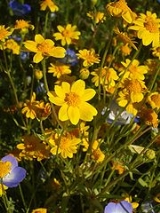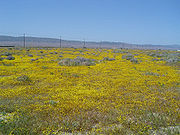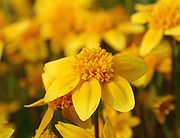
Lasthenia
Encyclopedia
Lasthenia, commonly known as goldfields, is a genus
of the botanical
family
Asteraceae
. The genus is named after Lasthenia, a cross-dressing
female pupil of the ancient Greek
philosopher Plato
.
.
Inflorescence
s are characterized by solitary heads (sometimes in cymes), with phyllaries
free or partly fused. The receptacle may present as naked and narrowly conic to hemispheric
. The normally yellow ray flowers may number four to 16, and the ligule
s are typically yellow as well. The disk flowers are numerous and generally yellow corollae are typically five-lobed; anther tips manifest as acuminate to triangular, while style tips may be triangular or round, but typically hair-tufted.
Fruits are less than five millimeters across, cylindric to obovoid in shape, and black or gray in color. The pappus
may present awns or scales, or infrequently neither. The genus is mostly cross-pollinated, with some insects serving as pollinators.

, such as meadows, shrubland and open forest, but tend towards semiarid conditions. They are commonly found at ephemeral pools and are important plants in coastal regions. They are visited by Sciaridae
fungus gnats for nectar, and it is possible that these animals are key pollinators at least for Contra Costa Goldfields (L. conjugens).
In horticulture
, most make hardy ornamental plant
s, suitable for flower-beds or borders. Autumn is the best time for sowing the seed, but it may also be sown early in the spring.
 There are a total of eighteen species
There are a total of eighteen species
, seventeen are endemic to North America
and one is only found in Chile
. Of the seventeen species found in North America
, most are endemic to California
.
Genus
In biology, a genus is a low-level taxonomic rank used in the biological classification of living and fossil organisms, which is an example of definition by genus and differentia...
of the botanical
Botany
Botany, plant science, or plant biology is a branch of biology that involves the scientific study of plant life. Traditionally, botany also included the study of fungi, algae and viruses...
family
Family (biology)
In biological classification, family is* a taxonomic rank. Other well-known ranks are life, domain, kingdom, phylum, class, order, genus, and species, with family fitting between order and genus. As for the other well-known ranks, there is the option of an immediately lower rank, indicated by the...
Asteraceae
Asteraceae
The Asteraceae or Compositae , is an exceedingly large and widespread family of vascular plants. The group has more than 22,750 currently accepted species, spread across 1620 genera and 12 subfamilies...
. The genus is named after Lasthenia, a cross-dressing
Cross-dressing
Cross-dressing is the wearing of clothing and other accoutrement commonly associated with a gender within a particular society that is seen as different than the one usually presented by the dresser...
female pupil of the ancient Greek
Ancient Greece
Ancient Greece is a civilization belonging to a period of Greek history that lasted from the Archaic period of the 8th to 6th centuries BC to the end of antiquity. Immediately following this period was the beginning of the Early Middle Ages and the Byzantine era. Included in Ancient Greece is the...
philosopher Plato
Plato
Plato , was a Classical Greek philosopher, mathematician, student of Socrates, writer of philosophical dialogues, and founder of the Academy in Athens, the first institution of higher learning in the Western world. Along with his mentor, Socrates, and his student, Aristotle, Plato helped to lay the...
.
Description
The goldfield genus comprises annual, rarely perennial herbs that are as either glabrous or hairy. Stems are typically branched and erect, attaining a height of less than 60 centimeters. Their opposite leaves, of length of up to 20 centimeters are entire to pinnatePinnate
Pinnate is a term used to describe feather-like or multi-divided features arising from both sides of a common axis in plant or animal structures, and comes from the Latin word pinna meaning "feather", "wing", or "fin". A similar term is pectinate, which refers to a comb-like arrangement of parts...
.
Inflorescence
Inflorescence
An inflorescence is a group or cluster of flowers arranged on a stem that is composed of a main branch or a complicated arrangement of branches. Strictly, it is the part of the shoot of seed plants where flowers are formed and which is accordingly modified...
s are characterized by solitary heads (sometimes in cymes), with phyllaries
Bract
In botany, a bract is a modified or specialized leaf, especially one associated with a reproductive structure such as a flower, inflorescence axis, or cone scale. Bracts are often different from foliage leaves. They may be smaller, larger, or of a different color, shape, or texture...
free or partly fused. The receptacle may present as naked and narrowly conic to hemispheric
Sphere
A sphere is a perfectly round geometrical object in three-dimensional space, such as the shape of a round ball. Like a circle in two dimensions, a perfect sphere is completely symmetrical around its center, with all points on the surface lying the same distance r from the center point...
. The normally yellow ray flowers may number four to 16, and the ligule
Ligule
A ligule — is a thin outgrowth at the junction of leaf and leafstalk of many grasses and sedges or a strap-shaped corolla, such as that of a ray floret in plants in the daisy family....
s are typically yellow as well. The disk flowers are numerous and generally yellow corollae are typically five-lobed; anther tips manifest as acuminate to triangular, while style tips may be triangular or round, but typically hair-tufted.
Fruits are less than five millimeters across, cylindric to obovoid in shape, and black or gray in color. The pappus
Pappus (flower structure)
The pappus is the modified calyx, the part of an individual disk, ray or ligule floret surrounding the base of the corolla, in flower heads of the plant family Asteraceae. The pappus may be composed of bristles , awns, scales, or may be absent. In some species, the pappus is too small to see...
may present awns or scales, or infrequently neither. The genus is mostly cross-pollinated, with some insects serving as pollinators.

Ecology and horticulture
Goldfield species occur over a range of habitatHabitat
* Habitat , a place where a species lives and grows*Human habitat, a place where humans live, work or play** Space habitat, a space station intended as a permanent settlement...
, such as meadows, shrubland and open forest, but tend towards semiarid conditions. They are commonly found at ephemeral pools and are important plants in coastal regions. They are visited by Sciaridae
Sciaridae
Sciaridae is a family of flies, commonly known as dark-winged fungus gnats. Commonly found in moist environments, they are known to be a pest of mushroom farms and are commonly found in household plant pots. This is one of the least studied of the large Diptera families, probably due to the small...
fungus gnats for nectar, and it is possible that these animals are key pollinators at least for Contra Costa Goldfields (L. conjugens).
In horticulture
Horticulture
Horticulture is the industry and science of plant cultivation including the process of preparing soil for the planting of seeds, tubers, or cuttings. Horticulturists work and conduct research in the disciplines of plant propagation and cultivation, crop production, plant breeding and genetic...
, most make hardy ornamental plant
Ornamental plant
Ornamental plants are plants that are grown for decorative purposes in gardens and landscape design projects, as house plants, for cut flowers and specimen display...
s, suitable for flower-beds or borders. Autumn is the best time for sowing the seed, but it may also be sown early in the spring.
Species

Species
In biology, a species is one of the basic units of biological classification and a taxonomic rank. A species is often defined as a group of organisms capable of interbreeding and producing fertile offspring. While in many cases this definition is adequate, more precise or differing measures are...
, seventeen are endemic to North America
North America
North America is a continent wholly within the Northern Hemisphere and almost wholly within the Western Hemisphere. It is also considered a northern subcontinent of the Americas...
and one is only found in Chile
Chile
Chile ,officially the Republic of Chile , is a country in South America occupying a long, narrow coastal strip between the Andes mountains to the east and the Pacific Ocean to the west. It borders Peru to the north, Bolivia to the northeast, Argentina to the east, and the Drake Passage in the far...
. Of the seventeen species found in North America
North America
North America is a continent wholly within the Northern Hemisphere and almost wholly within the Western Hemisphere. It is also considered a northern subcontinent of the Americas...
, most are endemic to California
California
California is a state located on the West Coast of the United States. It is by far the most populous U.S. state, and the third-largest by land area...
.
- Lasthenia burkeiLasthenia burkeiLasthenia burkei is a rare species of flowering plant in the daisy family known by the common names Burke's goldfields and Burke's baeria. It is endemic to California, where it is known from three counties north of the San Francisco Bay Area. It grows in moist spring meadows and vernal pools...
– Burke's Goldfields (endemic to California, endangered) - Lasthenia californicaLasthenia californicaLasthenia californica is a species of flowering plant in the daisy family known by the common name California goldfields. It is native to California and Oregon and surrounding areas, where it is a very common member of the flora in a number of habitat types. This is an annual herb approaching a...
– California Goldfields (found in northern California and OregonOregonOregon is a state in the Pacific Northwest region of the United States. It is located on the Pacific coast, with Washington to the north, California to the south, Nevada on the southeast and Idaho to the east. The Columbia and Snake rivers delineate much of Oregon's northern and eastern...
) - Lasthenia chrysanthaLasthenia chrysanthaLasthenia chrysantha is a species of flowering plant in the daisy family known by the common name alkalisink goldfields. It is endemic to the California Central Valley, where it grows in vernal pools and alkali flats. This is an annual herb approaching a maximum height near 28 centimeters...
– Alkali-sink Goldfields (endemic to California) - Lasthenia conjugensLasthenia conjugensLasthenia conjugens, commonly known as Contra Costa goldfields, is an endangered species of wildflower endemic to a limited range within the San Francisco Bay Area of the state of California, USA. Specifically this rare species occurs in Napa, Santa Barbara , Solano, Contra Costa, Santa Clara,...
– Contra Costa Goldfields (endemic to California, endangered) - Lasthenia coronariaLasthenia coronariaLasthenia coronaria is a species of flowering plant in the daisy family known by the common name royal goldfields. It is native to California and Baja California, including Guadalupe Island. This is an annual herb approaching a maximum height near 40 centimeters...
– Crowned Goldfields, Royal Goldfields (found in California and northern MexicoMexicoThe United Mexican States , commonly known as Mexico , is a federal constitutional republic in North America. It is bordered on the north by the United States; on the south and west by the Pacific Ocean; on the southeast by Guatemala, Belize, and the Caribbean Sea; and on the east by the Gulf of...
) - Lasthenia debilis – Greene's Goldfields (endemic to California)
- Lasthenia ferrisiaeLasthenia ferrisiaeLasthenia ferrisiae is a species of flowering plant in the daisy family known by the common name Ferris' goldfields. It is endemic to the California Central Valley, where it grows in vernal pools and alkali flats. This is an annual herb approaching a maximum height near 40 centimeters...
– Ferris's Goldfields (endemic to California) - Lasthenia fremontiiLasthenia fremontiiLasthenia fremontii is a species of flowering plant in the daisy family known by the common name Frémont's goldfields . It is endemic to the California Central Valley, where it grows in vernal pools and meadows. This is an annual herb approaching a maximum height near 35 centimeters...
– Fremont's Goldfields (endemic to California) - Lasthenia glaberrimaLasthenia glaberrimaLasthenia glaberrima is a species of flowering plant in the daisy family known by the common names smooth goldfields and rayless goldfields. It is native to western North America from British Columbia to California, where it grows in wet places such as vernal pools and springtime meadows...
– Smooth Goldfields (found in California, Oregon, Washington, and British ColumbiaBritish ColumbiaBritish Columbia is the westernmost of Canada's provinces and is known for its natural beauty, as reflected in its Latin motto, Splendor sine occasu . Its name was chosen by Queen Victoria in 1858...
) - Lasthenia glabrataLasthenia glabrataLasthenia glabrata is a species of flowering plant in the daisy family known by the common name yellowray goldfields. It is endemic to California, where it is a resident of vernal pools and other moist areas in a number of habitat types. This is a daisylike annual herb growing up to about half a...
– Yellow-ray Goldfields (endemic to California) - Lasthenia gracilis – Common Goldfields (found in California, ArizonaArizonaArizona ; is a state located in the southwestern region of the United States. It is also part of the western United States and the mountain west. The capital and largest city is Phoenix...
, the Channel Islands of CaliforniaChannel Islands of CaliforniaThe Channel Islands of California are a chain of eight islands located in the Pacific Ocean off the coast of Southern California along the Santa Barbara Channel in the United States of America...
, and northern MexicoMexicoThe United Mexican States , commonly known as Mexico , is a federal constitutional republic in North America. It is bordered on the north by the United States; on the south and west by the Pacific Ocean; on the southeast by Guatemala, Belize, and the Caribbean Sea; and on the east by the Gulf of...
) - Lasthenia kunthii – Chilean Goldfields (found in vernal pools in ChileChileChile ,officially the Republic of Chile , is a country in South America occupying a long, narrow coastal strip between the Andes mountains to the east and the Pacific Ocean to the west. It borders Peru to the north, Bolivia to the northeast, Argentina to the east, and the Drake Passage in the far...
) - Lasthenia leptalea – Salinas Valley Goldfields (endemic to California)
- Lasthenia maritimaLasthenia maritimaLasthenia maritima is a species of flowering plant in the daisy family known by the common name maritime goldfields. It is native to the coastline of western North America, where it is found almost exclusively on small rocky, coastal islands in the Pacific Ocean between Vancouver Island in British...
– Maritime Goldfields, Seaside Goldfields (found along the coast and offshore islands and islets from California to British Columbia) - Lasthenia microglossaLasthenia microglossaLasthenia microglossa is a species of flowering plant in the daisy family known by the common name smallray goldfields. It is endemic to California, where it grows in shady areas in a number of habitats. This is a small annual herb growing sprawling stems along the ground or erect to a maximum...
– Small-ray Goldfields (endemic to California) - Lasthenia minorLasthenia minorLasthenia minor is a species of flowering plant in the daisy family known by the common name coastal goldfields. It is native to California, where it is a resident of coastal and inland grassland habitat. This is an annual herb growing erect to a maximum height near 35 centimeters. The woolly stem...
– Coastal Goldfields (endemic to coastal and inland California) - Lasthenia ornduffii – Ornduff's Goldfields (endemic to Oregon, endangered)
- Lasthenia platycarphaLasthenia platycarphaLasthenia platycarpha is a species of flowering plant in the daisy family known by the common name alkali goldfields. It is endemic to California, where it is known mainly from the Central Valley. It grows in alkali flats and other areas with alkaline soils. This is an annual herb producing an...
– Alkali Goldfields (endemic to California)

